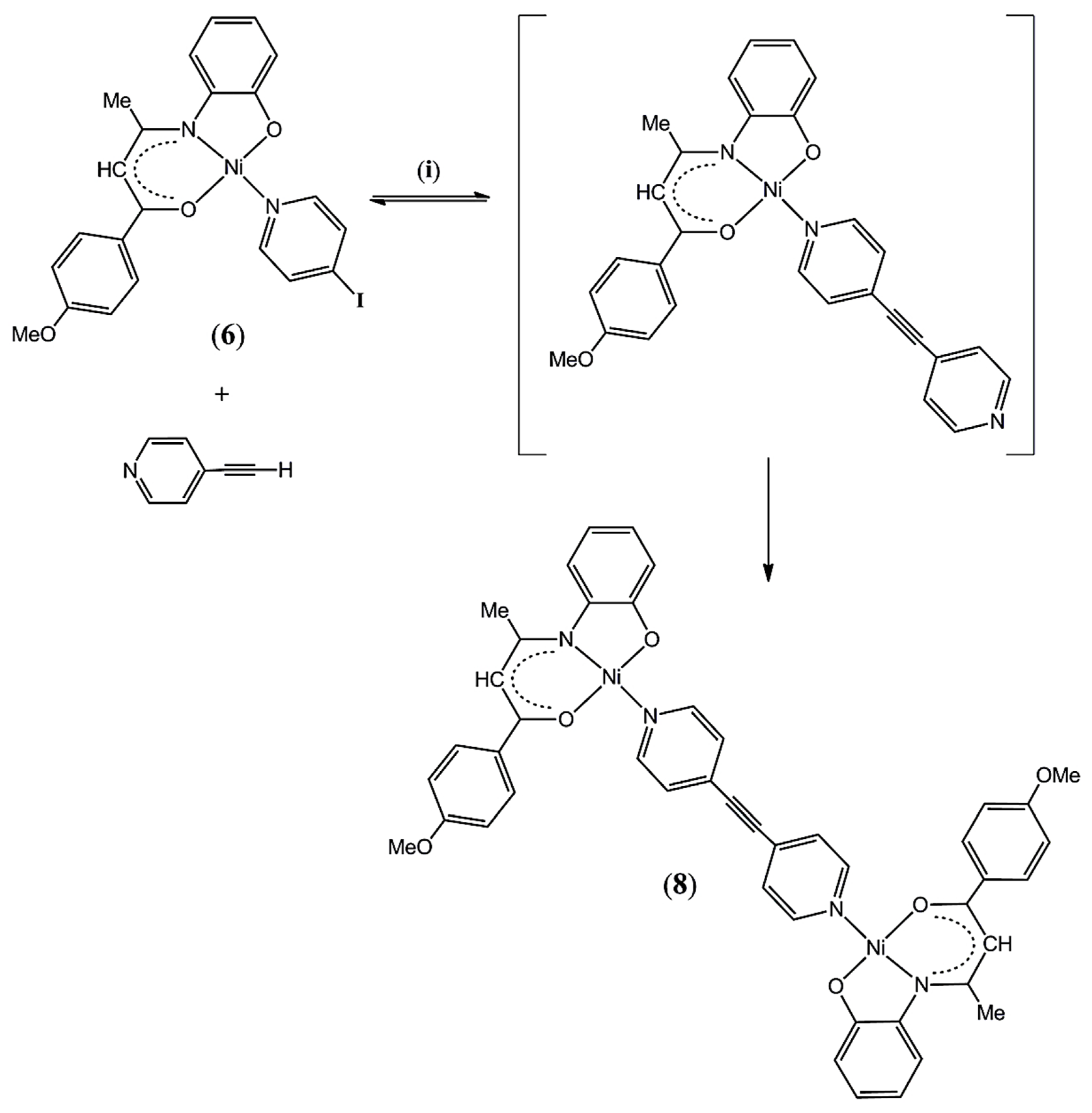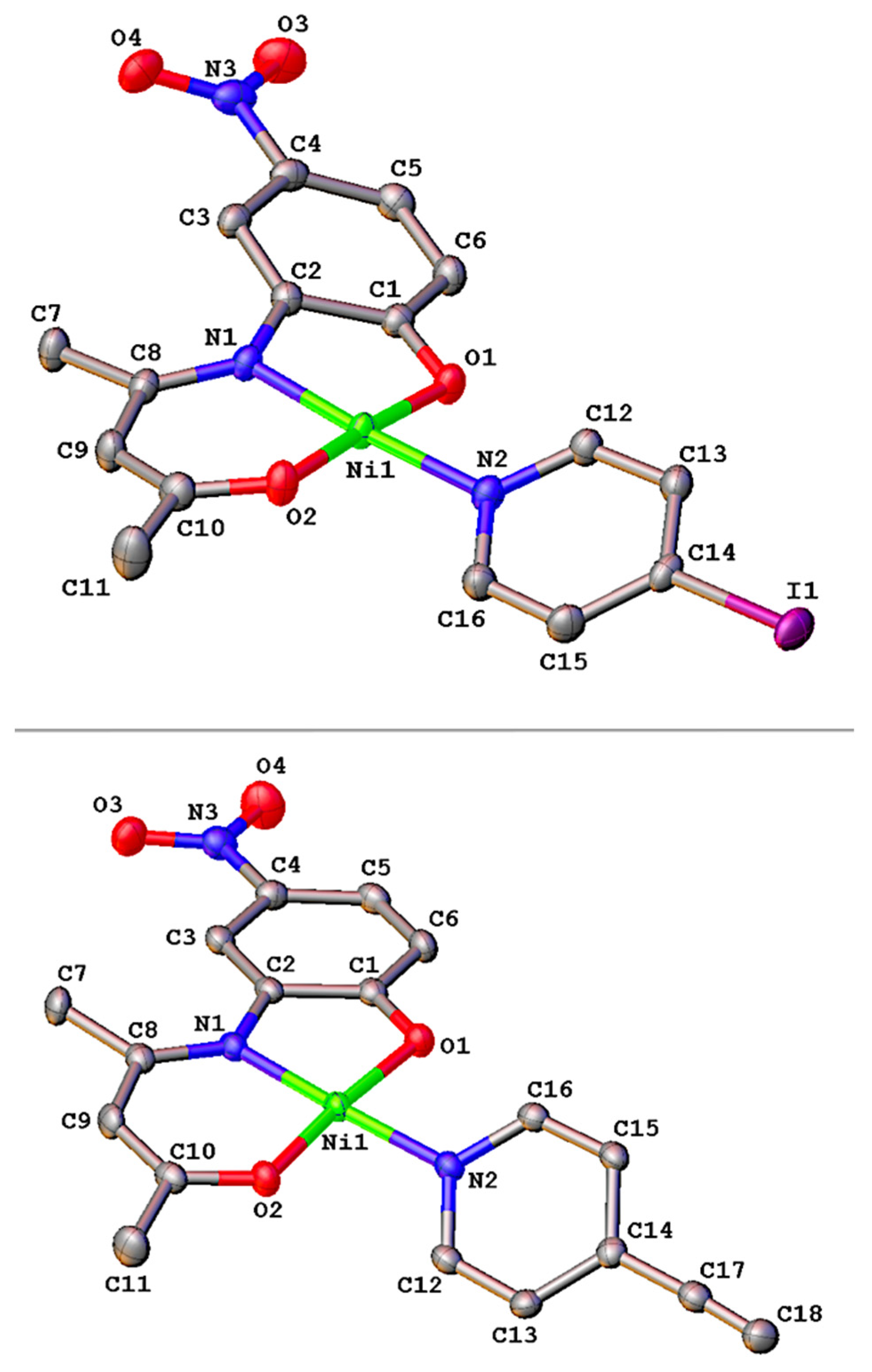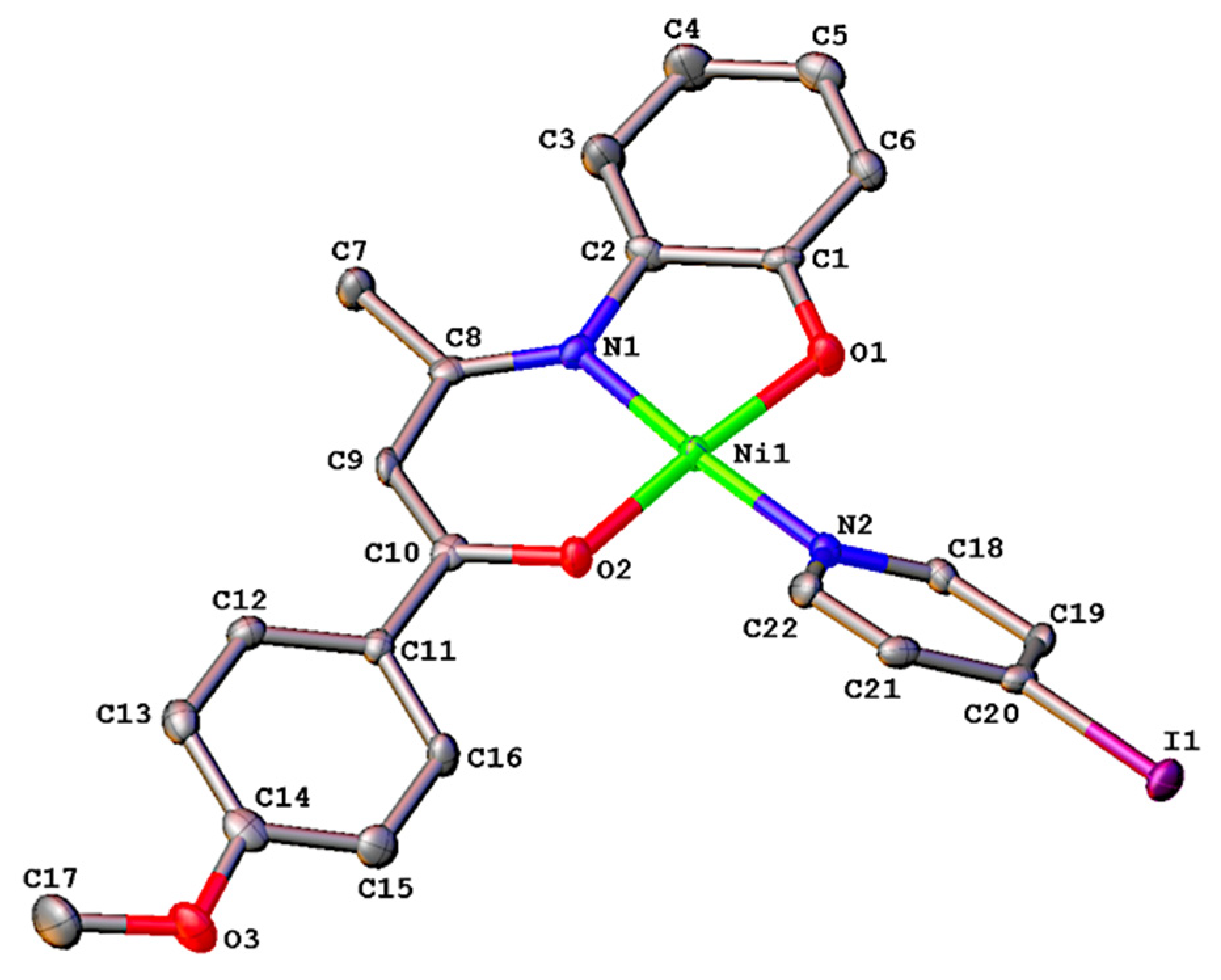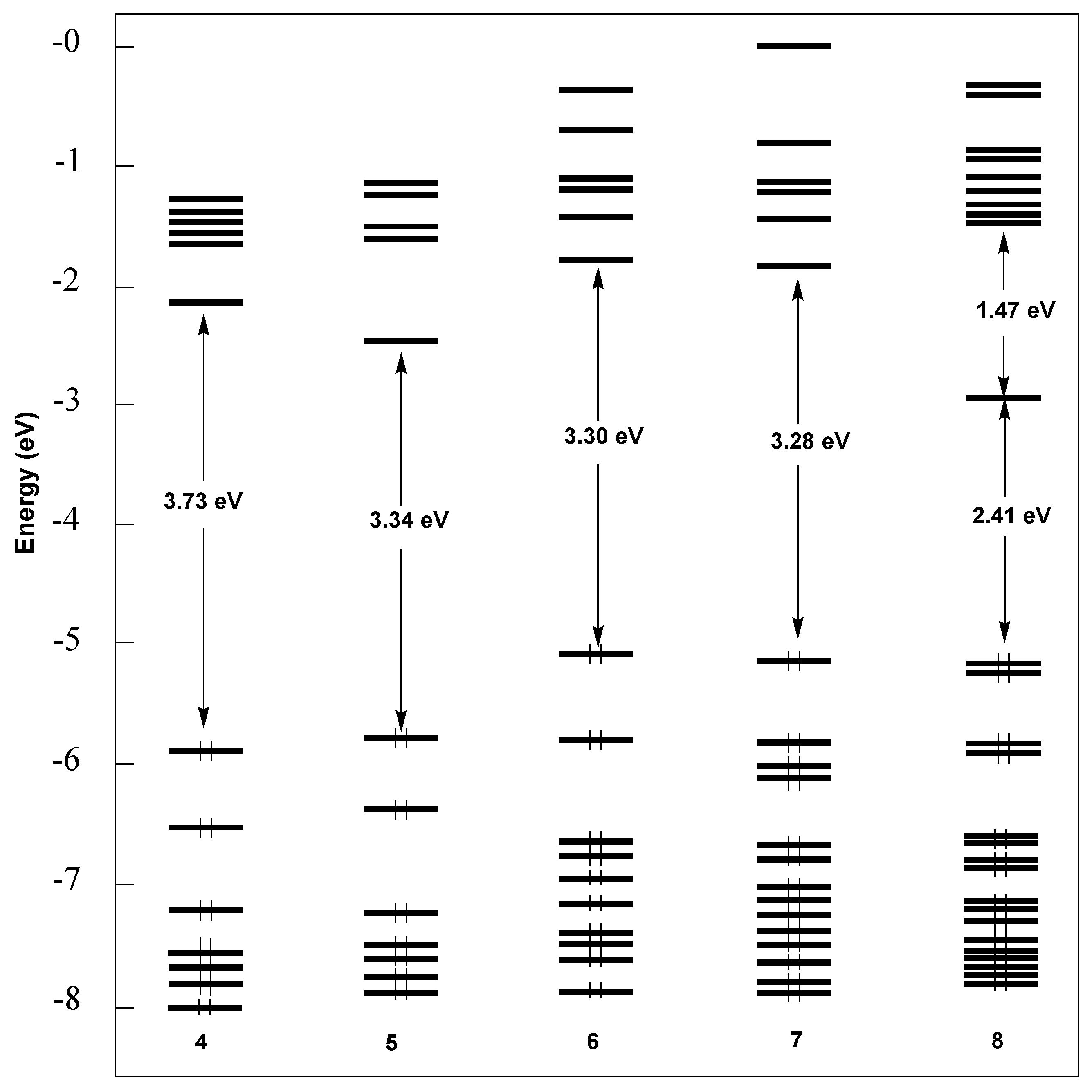Nickel(II)-Based Building Blocks with Schiff Base Derivatives: Experimental Insights and DFT Calculations †
Abstract
:1. Introduction
2. Results and Discussion
2.1. Synthesis and Characterization
2.2. Description of Crystal Structures
2.3. DFT Analysis
3. Materials and Methods
3.1. Materials and Physical Measurements
3.2. Synthesis of the Complexes
3.2.1. [{CH3-C(O)CH=C(CH3)N-C6H3(4-NO2)-2-O}Ni(NC5H4I)] (4)
3.2.2. [{CH3-C(O)CH=C(CH3)N-C6H3(4-NO2)-2-O}Ni(4-NC5H4-C≡CH)] (5)
3.2.3. [{4-MeO-C6H4-C(O)CH=C(CH3)N-C6H4-2-O}Ni(4-NC5H4I)] (6)
3.2.4. [{CpFe(C5H4)-C(O)CH=C(CH3)N-C6H4-2-O}Ni(4-NC5H4I)] (7)
3.2.5. [{(4-MeO-C6H4-C(O)CH=C(CH3)N-C6H4-2-O)Ni}2(µ-NC5H4-C≡C-C5H4N)] (8)
3.3. X-ray Crystal Structure Determinations
3.4. Computational Details
4. Conclusions
Supplementary Materials
Author Contributions
Funding
Institutional Review Board Statement
Informed Consent Statement
Data Availability Statement
Acknowledgments
Conflicts of Interest
Sample Availability
References
- Qin, W.; Long, S.; Panunzio, M.; Biondi, S. Schiff bases: A short survey on an evergreen chemistry tool. Molecules 2013, 18, 12264–12289. [Google Scholar] [CrossRef] [PubMed]
- Fabbrizzi, L. Beauty in Chemistry: Making Artistic Molecules with Schiff Bases. J. Org. Chem. 2020, 85, 12212–12226. [Google Scholar] [CrossRef]
- Vigato, P.A.; Tamburini, S. The challenge of cyclic and acyclic schiff bases and related derivatives. Coord. Chem. Rev. 2004, 248, 1717–2128. [Google Scholar] [CrossRef]
- Hylland, K.T.; Gerz, I.; DWragg, S.; Oien-Odegaard, S.; Tilset, M. The Reactivity of Multidentate Schiff Base Ligands Derived from Bi- and Terphenyl Polyamines towards M(II) (M=Ni, Cu, Zn, Cd) and M(III) (M=Co, Y, Lu). Eur. J. Inorg. Chem. 2021, 1869–1889. [Google Scholar] [CrossRef]
- Karmakar, M.; Chattopadhyay, S. A comprehensive overview of the orientation of tetradentate N2O2 donor Schiff base ligands in octahedral complexes of trivalent 3d metals. J. Mol. Struct. 2019, 1186, 155–186. [Google Scholar] [CrossRef]
- Liu, X.; Hamon, J.-R. Recent developments in penta-, hexa- and heptadentate Schiff base ligands and their metal complexes. Coord. Chem. Rev. 2019, 389, 94–118. [Google Scholar] [CrossRef]
- Miroslaw, B. Homo- and Hetero-Oligonuclear Complexes of Platinum Group Metals (PGM) Coordinated by Imine Schiff Base Ligands. Int. J. Mol. Sci. 2020, 21, 3493. [Google Scholar] [CrossRef]
- Abu-Dief, M.; Mohamed, I.M.A. A review on versatile applications of transition metal complexes incorporating Schiff bases. J. Basic Appl. Sci. 2015, 4, 119–133. [Google Scholar] [CrossRef] [PubMed] [Green Version]
- Brodowska, K.; Łodyga-Chruscinska, E. Schiff bases: Interesting range of applications in various fields of science. Chemik 2014, 68, 645–647. [Google Scholar]
- Gupta, K.C.; Sutar, A.K. Catalytic activities of Schiff base transition metal complexes. Coord. Chem. Rev. 2008, 252, 1420–1450. [Google Scholar] [CrossRef]
- Das, P.; Linert, W. Schiff base-derived homogeneous and heterogeneous palladium catalysts for the Suzuki-Miyaura reaction. Coord. Chem. Rev. 2016, 311, 1–23. [Google Scholar] [CrossRef]
- Santoro, O.; Zhang, X.; Redshaw, C. Synthesis of Biodegradable Polymers: A Review on the Use of Schiff-Base Metal Complexes as Catalysts for the Ring Opening Polymerization (ROP) of Cyclic Esters. Catalysts 2020, 10, 800. [Google Scholar] [CrossRef]
- Balas, M.; Beaudoin, S.; Proust, A.; Launay, F.; Villanneau, R. Advantages of Covalent Immobilization of Metal-Salophen on Amino-Functionalized Mesoporous Silica in Terms of Recycling and Catalytic Activity for CO2 Cycloaddition onto Epoxides. Eur. J. Inorg. Chem. 2021, 1581–1591. [Google Scholar] [CrossRef]
- Schulz, E. Chiral Cobalt-Salen Complexes: Ubiquitous Species in Asymmetric Catalysis. Chem. Rec. 2021, 21, 427–439. [Google Scholar] [CrossRef] [PubMed]
- Berhanu, A.L.; Mohiuddin, I.; Malik, A.K.; Aulakh, J.S.; Kumar, V.; Kim, K.H. A review of the applications of Schiff bases as optical chemical sensors. Trends Anal. Chem. 2019, 116, 74–91. [Google Scholar] [CrossRef]
- Udhayakumari, D.; Inbaraj, V. A Review on Schiff Base Fluorescent Chemosensors for Cell Imaging Applications. J. Fluorescence 2020, 30, 1203–1223. [Google Scholar] [CrossRef]
- Niu, M.; Yang, X.; Ma, Y.; Hao, W.; Leng, X.; Schipper, D. Construction of Zn(II)/Cd(II)-Yb(III) Schiff Base Complexes for the NIR Luminescent Sensing of Fluoroquinolone Antibiotics. Inorg. Chem. 2021, 60, 5764–5770. [Google Scholar] [CrossRef] [PubMed]
- González, D.M.; Hernández, L.A.; Oyarce, J.; Alfaro, A.; Novoa, N.; Cisterna, J.; Brito, I.; Carrillo, D.; Manzur, C. A new and efficient high-performance electrochemical glucose sensor based on a metallopolymer derived from a cobaltate (III) Schiff base complex. Synth. Met. 2021, 271, 116633. [Google Scholar] [CrossRef]
- Nayar, C.R.; Ravikumar, R. Second order nonlinearities of Schiff bases derived from salicylaldehyde and their metal complexes. J. Coord. Chem. 2014, 67, 1–16. [Google Scholar] [CrossRef]
- Di Bella, S.; Colombo, A.; Dragonetti, C.; Righetto, S.; Roberto, D. Zinc(II) as a Versatile Template for Efficient Dipolar and Octupolar Second-Order Nonlinear Optical Molecular Materials. Inorganics 2018, 6, 133. [Google Scholar] [CrossRef] [Green Version]
- Rigamonti, L.; Forni, A.; Cariati, E.; Malavasi, G.; Pasini, A. Solid-State Nonlinear Optical Properties of Mononuclear Copper(II) Complexes with Chiral Tridentate and Tetradentate Schiff Base Ligands. Materials 2019, 12, 3595. [Google Scholar] [CrossRef] [PubMed] [Green Version]
- Celedón, S.; Roisnel, T.; Artigas, V.; Fuentealba, M.; Carrillo, D.; Ledoux-Rak, I.; Hamon, J.-R.; Manzur, C. Palladium (II) complexes of tetradentate donor-acceptor Schiff base ligands: Synthesis, spectral, structural, thermal and NLO properties. New J. Chem. 2020, 44, 9190–9201. [Google Scholar] [CrossRef]
- Arulmurugan, S.; Kavitha, H.P.; Venkatraman, B.R. Biological activities of Schiff base and its complexes: A review. Rasayan J. Chem. 2010, 3, 385–410. [Google Scholar]
- Kumar, J.; Rai, A.; Raj, V. A comprehensive review on the pharmacological activity of Schiff base containing derivatives. Org. Med. Chem. Int. J. 2017, 1, 555–564. [Google Scholar] [CrossRef]
- Kaczmarek, M.T.; Zabiszak, M.; Nowak, M.; Jastrzab, R. Lanthanides: Schiff base complexes, applications in cancer diagnosis, therapy, and antibacterial activity. Coord. Chem. Rev. 2018, 370, 42–54. [Google Scholar] [CrossRef]
- Hossain, M.S.; Roy, P.K.; Zakaria, C.; Kudrat-E-Zahan, M. Selected Schiff base coordination complexes and their microbial application: A review. Int. J. Chem. Stud. 2018, 6, 19–31. [Google Scholar]
- Gillard, M.; Weynand, J.; Bonnet, H.; Loiseau, F.; Decottignies, A.; Dejeu, J.; Defrancq, E.; Elias, B. Flexible RuII Schiff Base Complexes: G-Quadruplex DNA Binding and Photo-Induced Cancer Cell Death. Chem. Eur. J. 2020, 26, 13849–13860. [Google Scholar] [CrossRef] [PubMed]
- Rigamonti, L.; Reginato, F.; Ferrari, E.; Pigani, L.; Gigli, L.; Demitri, N.; Kopel, P.; Tesarova, B.; Heger, Z. From solid state to in vitro anticancer activity of copper(II) compounds with electronicallymodulated NNO Schiff base ligands. Dalton Trans. 2020, 49, 14626–14639. [Google Scholar] [CrossRef]
- Cozzi, P.G. Metal-Salen Schiff base complexes in catalysis: Practical aspects. Chem. Soc. Rev. 2004, 33, 410–421. [Google Scholar] [CrossRef]
- Liu, X.; Manzur, C.; Novoa, N.; Celedon, S.; Carrillo, D.; Hamon, J.-R. Multidentate unsymmetrically-substituted Schiff bases and their metal complexes: Synthesis, functional materials properties, and applications to catalysis. Coord. Chem. Rev. 2018, 357, 144–172. [Google Scholar] [CrossRef]
- Di Bella, S. Lewis acidic zinc(II) salen-type Schiff-base complexes: Sensing properties and responsive nanostructures. Dalton Trans. 2021, 50, 6050–6063. [Google Scholar] [CrossRef]
- Pessoa, J.C.; Correia, I. Salan vs. salen metal complexes in catalysis and medicinal applications: Virtues and pitfalls. Coord. Chem. Rev. 2019, 388, 227–247. [Google Scholar] [CrossRef]
- Erxleben, A. Transition metal salen complexes in bioinorganic and medicinal chemistry. Inorg. Chim. Acta 2018, 472, 40–57. [Google Scholar] [CrossRef]
- Bunda, S.; Voronova, K.; Kathó, A.; Udvardy, A.; Joó, F. Palladium (II)–Salan Complexes as Catalysts for Suzuki–Miyaura C–C Cross Coupling in Water and Air. Effect of the Various Bridging Units within the Diamine Moieties on the Catalytic Performance. Molecules 2020, 25, 3993. [Google Scholar] [CrossRef]
- Mondal, I.; Chattopadhyay, S. Development of multi-metallic complexes using metal-salen complexes as building blocks. J. Coord. Chem. 2019, 72, 3183–3209. [Google Scholar] [CrossRef]
- Freire, C.; Nunes, M.; Pereira, C.; Fernandes, D.M.; Peixoto, A.F.; Rocha, M. Metallo(salen) complexes as versatile building blocks for the fabrication of molecular materials and devices with tuned properties. Coord. Chem. Rev. 2019, 394, 104–134. [Google Scholar] [CrossRef]
- Cisterna, J.; Fuentealba, M.; Manzur, C.; Carrillo, D. Pentacoordinated Fe(III) complex containing the cis-N2O2 asymmetrical tetradentate Schiff base and p-Br-C6H4O- as ligands. Promising building block for the construction of dipolar D-π-A architectures: Synthesis, characterization, spectroscopic, electrochemical and structural studies. J. Mol. Struct. 2021, 1228, 129709. [Google Scholar] [CrossRef]
- Usman Anwar, M.; Al-Harrasi, A.; Rawson, J.M. Structures, properties and applications of Cu(II) complexes with tridentate donor ligands. Dalton Trans. 2021, 50, 5099–5108. [Google Scholar] [CrossRef]
- Ghorai, P.; Brandão, P.; Benmansour, S.; Gómez García, C.J.; Saha, A. Azido and thiocyanato bridged dinuclear Ni(II) complexes involving 8-aminoquinoline based Schiff base as blocking ligands: Crystal structures, ferromagnetic properties and magneto-structural correlations. Polyhedron 2020, 188, 114708. [Google Scholar] [CrossRef]
- Thakurta, S.; Maiti, M.; Butcher, R.J.; Gómez-García, C.J.; Tsaturyan, A.A. A trinuclear nickel(II) Schiff base complex with phenoxido- and acetato-bridges: Combined experimental and theoretical magneto-structural correlation. Dalton Trans. 2021, 50, 2200–2209. [Google Scholar] [CrossRef]
- Dinda, R.; Ghosh, S.; Falvello, L.R.; Tomás, M.; Mak, T.C.W. Synthesis, structure, and reactivity of some new dipyridyl and diamine-bridged dinuclear oxomolybdenum(VI) complexes. Polyhedron 2006, 25, 2375–2382. [Google Scholar] [CrossRef]
- Rigamonti, L.; Forni, A.; Pievo, R.; Reedijk, J.; Pasini, A. Synthesis, crystal structures and magnetic properties of dinuclear copper(II) compounds with NNO tridentate Schiff base ligands and bridging aliphatic diamine and aromatic diimine linkers. Dalton Trans. 2011, 40, 3381–3393. [Google Scholar] [CrossRef]
- Bhowmik, P.; Kanta Das, L.; Bauzá, A.; Chattopadhyay, S.; Frontera, A.; Ghosh, A. Anion dependent supramolecular architectures in Cu(II) complexes containing N2O-donor Schiff-base and 4,4′-bipyridine ligands: Structural analyses and theoretical studies. Inorg. Chim. Acta 2016, 448, 26–33. [Google Scholar] [CrossRef]
- Novoa, N.; Roisnel, T.; Dorcet, V.; Cador, O.; Manzur, C.; Carrillo, D.; Hamon, J.-R. Efficient preparation of multimetallic ONO-based Schiff base complexes of nickel(II) and copper(II). New J. Chem. 2016, 40, 5920–5929. [Google Scholar] [CrossRef]
- Di Bella, S.; Dragonetti, C.; Pizzotti, M.; Roberto, D.; Tessore, F.; Ugo, R. Coordination and Organometallic Complexes as Second-Order Nonlinear Optical Molecular Materials. Top. Organomet. Chem. 2010, 28, 1–55. [Google Scholar] [CrossRef]
- Liang, L.; Astruc, D. The Copper(I)-catalyzed Alkyne-Azide Cycloaddition (CuAAC) “Click” Reaction and its Applications. An Overview. Coord. Chem. Rev. 2011, 255, 2933–2945. [Google Scholar] [CrossRef]
- Hooshmand, S.E.; Heidari, B.; Sedghi, R.; Varma, R.S. Recent advances in the Suzuki-Miyaura cross-coupling reaction using efficient catalysts in eco-friendly media. Green Chem. 2019, 21, 381–405. [Google Scholar] [CrossRef]
- Chinchilla, R.; Najera, C. Recent advances in Sonogashira reactions. Chem. Soc. Rev. 2011, 40, 5084–5121. [Google Scholar] [CrossRef] [PubMed]
- Novoa, N.; Roisnel, T.; Hamon, P.; Kahlal, S.; Manzur, C.; Ngo, H.M.; Ledoux-Rak, I.; Saillard, J.-Y.; Carrillo, D.; Hamon, J.-R. Four-Coordinate Nickel(II) and Copper(II) Complexes Based ONO Tridentate Schiff Base Ligands: Synthesis, Molecular Structure, Electrochemical, Linear and Nonlinear Properties, and Computational Study. Dalton Trans. 2015, 44, 18019–18037. [Google Scholar] [CrossRef]
- Novoa, N.; Justaud, F.; Hamon, P.; Roisnel, T.; Cador, O.; Le Guennic, B.; Manzur, C.; Carrillo, D.; Hamon, J.-R. Doubly Phenoxide-Bridged Binuclear Copper(II) Complexes with ONO Tridentate Schiff Base Ligand: Synthesis, Structural, Magnetic and Theoretical studies. Polyhedron 2015, 86, 81–88. [Google Scholar] [CrossRef] [Green Version]
- Novoa, N.; Manzur, C.; Roisnel, T.; Dorcet, V.; Cabon, N.; Robin-Le Guen, F.; Ledoux-Rak, I.; Kahlal, S.; Saillard, J.-Y.; Carrillo, D.; et al. Redox-Switching of ternary Ni(II) and Cu(II) complexes: Synthesis, experimental and theoretical studies along with second-order nonlinear optical properties. New J. Chem. 2019, 43, 10468–10481. [Google Scholar] [CrossRef]
- Kubota, M.; Ohba, S.; Saito, Y. Structure of trans-Diiodobis(triphenylphosphine) palladium(II)-trichloromethane (1/1). Acta Crystallogr. Sect. C 1991, 47, 1727–1729. [Google Scholar] [CrossRef]
- Celedón, S.; Roisnel, T.; Carrillo, D.; Ledoux-Rak, I.; Hamon, J.-R.; Manzur, C. Transition metal(II) complexes featuring push-pull dianionic Schiff base ligands: Synthesis, crystal structure, electrochemical and NLO studies. J. Coord. Chem. 2020, 73, 3079–3094. [Google Scholar] [CrossRef]
- Yang, L.; Powell, D.R.; Houser, R.P. Structural variation in copper(I) complexes with pyridylmethylamide ligands: Structural analysis with a new four-coordinate geometry index, τ4. Dalton Trans. 2007, 955–964. [Google Scholar] [CrossRef]
- Allen, F.H.; Kennard, O.; Watson, D.G.; Brammer, L.; Orpen, A.G.; Taylor, R. Tables of bond lengths determined by X-ray and neutron diffraction. Part 1. Bond lengths in organic compounds. J. Chem. Soc. Perkin Trans. 1987, 2, S1–S19. [Google Scholar] [CrossRef]
- Dankhoff, K.; Lochenie, C.; Puchtler, F.; Weber, B. Solvent Influence on the Magnetic Properties of Iron(II) Spin-Crossover Coordination Compounds with 4,4′-Dipyridylethyne as Linker. Eur. J. Inorg. Chem. 2016, 2136–2143. [Google Scholar] [CrossRef] [Green Version]
- Armarego, W.L.F.; Chai, C.L.L. Purification of Laboratory Chemicals, 5th ed.; Butterworth-Heinemann, Elsevier Inc.: Amsterdam, The Netherlands, 2003; ISBN 9780750675710. [Google Scholar]
- Singh, R.V.; Tandon, J.P. Synthesis of Hexa-coordinated Ketimine Derivatives of Germanium(IV). J. Prakt. Chem. 1979, 321, 141–150. [Google Scholar] [CrossRef]
- Lazić, V.; Jurković, M.; Jednaćak, T.; Hrenar, T.; Parlov Vuković, J.; Novak, P. Intra- and intermolecular hydrogen bonding in acetylacetone and benzoylacetone derived enaminone derivatives. J. Mol. Struct. 2015, 1079, 243–249. [Google Scholar] [CrossRef]
- Sheldrick, G.M. SHELXT—Integrated space-group and crystal-structure determination. Acta Crystallogr. Sect. A 2015, 71, 3–8. [Google Scholar] [CrossRef] [PubMed] [Green Version]
- Sheldrick, G.M. Crystal structure refinement with SHELXL. Acta Crystallogr. Sect. C 2015, 71, 3–8. [Google Scholar] [CrossRef]
- Van Der Sluis, P.; Spek, A.L. BYPASS: An effective method for the refinement of crystal structures containing disordered solvent regions. Acta Crystallogr. Sect. A 1990, 46, 194–201. [Google Scholar] [CrossRef]
- Spek, A.L. Single-crystal structure validation with the program PLATON. J. Appl. Crystallogr. 2003, 36, 7–13. [Google Scholar] [CrossRef] [Green Version]
- Dolomanov, O.V.; Bourhis, L.J.; Gildea, R.J.; Howard, J.A.K.; Puschmann, H. OLEX2: A complete structure solution, refinement and analysis program. J. Appl. Crystallogr. 2009, 42, 339–341. [Google Scholar] [CrossRef]
- Reddy, D.S.; Kutateladze, A.G. Structure Revision of an Acorane Sesquiterpene Cordycepol A. Org. Lett. 2016, 18, 4860–4863. [Google Scholar] [CrossRef]
- Kutateladze, A.G.; Reddy, D.S. High-Throughput in Silico Structure Validation and Revision of Halogenated Natural Products Is Enabled by Parametric Corrections to DFT-Computed 13C NMR Chemical Shifts and Spin-Spin Coupling Constants. J. Org. Chem. 2017, 82, 3368–3381. [Google Scholar] [CrossRef]
- Kutateladze, A.G.; Holt, T.; Reddy, D.S. Natural Products Containing the Oxetane and Related Moieties Present Additional Challenges for Structure Elucidation: A DU8+ Computational Case Study. J. Org. Chem. 2019, 84, 7575–7586. [Google Scholar] [CrossRef] [PubMed]
- Frisch, M.J.; Trucks, G.W.; Schlegel, H.B.; Scuseria, G.E.; Robb, M.A.; Cheeseman, J.R.; Scalmani, G.; Barone, V.; Petersson, G.A.; Nakatsuji, H.; et al. Gaussian 16, Revision C.01; Gaussian, Inc.: Wallingford, CT, USA, 2016. [Google Scholar]
- Schaefer, A.; Horn, H.; Ahlrichs, R.J. Fully optimized contracted Gaussian basis sets for atoms Li to Kr. J. Chem. Phys. 1992, 97, 2571–2577. [Google Scholar] [CrossRef]
- Schaefer, A.; Huber, C.; Ahlrichs, R.J. Fully optimized contracted Gaussian basis sets of triple zeta valence quality for atoms Li to Kr. J. Chem. Phys. 1994, 100, 5829–5835. [Google Scholar] [CrossRef]
- Perdew, J.P.; Burke, K.; Ernzerhof, M. Generalized Gradient Approximation Made Simple. Phys. Rev. Lett. 1996, 77, 3865–3868. [Google Scholar] [CrossRef] [PubMed] [Green Version]
- Perdew, J.P.; Burke, K.; Ernzerhof, M. Generalized Gradient Approximation Made Simple (errata). Phys. Rev. Lett. 1997, 78, 1396. [Google Scholar] [CrossRef] [Green Version]
- Adamo, C.; Barone, V. Toward reliable density functional methods without adjustable parameters: The PBE0 model. J. Chem. Phys. 1999, 110, 6158–6169. [Google Scholar] [CrossRef]
- Szczepanik, D.W.; Sola, M.; Andrzejak, M.; Pawełek, B.; Dominikowska, J.; Kukułka, M.; Dyduch, K.; Krygowski, T.M.; Szatylowic, H. The Role of the Long-Range Exchange Corrections in the Description of Electron Delocalization in Aromatic Species. J. Comput. Chem. 2017, 38, 1640–1654. [Google Scholar] [CrossRef] [PubMed] [Green Version]
- Mahmoudi, G.; Babashkina, M.G.; Maniukiewicz, W.; Afkhami, F.A.; Nunna, B.B.; Zubkov, F.I.; Ptaszek, A.L.; Szczepanik, D.W.; Mitoraj, M.P.; Safin, D.A. Solvent-Induced Formation of Novel Ni(II) Complexes Derived from Bis-Thiosemicarbazone Ligand: An Insight from Experimental and Theoretical Investigations. Int. J. Mol. Sci. 2021, 22, 5337. [Google Scholar] [CrossRef]
- Mitoraj, M.P.; Babashkina, M.G.; Robeyns, K.; Sagan, F.; Szczepanik, D.W.; Seredina, Y.V.; Garcia, Y.; Safin, D.A. Chameleon-like Nature of Anagostic Interactions and Its Impact on Metalloaromaticity in Square-Planar Nickel Complexes. Organometallics 2019, 38, 1973–1981. [Google Scholar] [CrossRef]
- Henderson, T.M.; Izmaylov, A.F.; Scalmani, G.; Scuseria, G.E. Can short-range hybrids describe long-range-dependent properties? J. Chem. Phys. 2009, 131, 044108. [Google Scholar] [CrossRef] [PubMed]
- Glendening, E.D.; Badenhoop, J.K.; Reed, A.E.; Carpenter, J.E.; Bohmann, J.A.; Morales, C.L.; Weinhold, F. NBO 6.0; Theoretical Chemistry Institute, University of Wisconsin: Madison, WI, USA, 2013; Available online: http://nbo6.chem.wisc.edu (accessed on 16 March 2021).







| KERRYPNX | 4 | 5 | 6 | 7 a | 8 |
|---|---|---|---|---|---|
| Bond distances | |||||
| Ni(1)-O(1) | 1.8365(14) 1.830 [0.368] | 1.828(2) 1.831 [0.367] | 1.819(3) 1.823 [0.388] | 1.824 [0.388] | 1.766(6) b, 1.892(5) b 1.823 [0.387] |
| Ni(1)-O(2) | 1.8313(14) 1.831 [0.334] | 1.817(2) 1.832 [0.334] | 1.812(3) 1.834 [0.323] | 1.836 [0.322] | 1.817(2) 1.833 [0.323] |
| Ni(1)-N(1) | 1.8786(16) 1.877 [0.399] | 1.880(2) 1.877 [0.397] | 1.880(3) 1.874 [0.403] | 1.872 [0.404] | 1.876(3) 1.873 [0.404] |
| Ni(1)-N(2) | 1.9402(16) 1.954 [0.291] | 1.920(2) 1.949 [0.295] | 1.924(3) 1.951 [0.286] | 1.950 [0.286] | 1.962(3) 1.951 [0.289] |
| Bond angles | |||||
| O(1)-Ni(1)-O(2) | 176.53(6) 176 | 174.92(9) 177 | 173.55(13) 176 | 175 | 167.39(19) 176 |
| N(1)-Ni(1)-N(2) | 175.88(7) 175 | 175.73(10) 175 | 175.22(15) 175 | 176 | 174.85(11) 175 |
| O(1)-Ni(1)-N(1) | 87.39(7) 87 | 87.44(9) 87 | 88.34(14) 87 | 87 | 86.8(2) 87 |
| O(1)-Ni(1)-N(2) | 88.84(7) 89 | 88.58(9) 89 | 87.01(14) 88 | 88 | 88.10(19) 88 |
| O(2)-Ni(1)-N(1) | 95.96(7) 97 | 97.60(9) 96 | 97.72(14) 97 | 96 | 97.18(10) 96 |
| O(2)-Ni(1)-N(2) | 87.83(7) 88 | 86.36(9) 88 | 86.97(14) 88 | 88 | 87.93(10) 88 |
| 4 | 5 | 6 | 7 | 8 | |
|---|---|---|---|---|---|
| F | 1.03 | 1.03 | 1.03 | 1.03 | 1.03 |
| N(1) | −0.52 | −0.52 | −0.51 | −0.51 | −0.51 |
| N(2) | −0.46 | −0.45 | −0.45 | −0.45 | −0.45 |
| O(1) | −0.71 | −0.71 | −0.73 | −0.73 | −0.73 |
| O(2) | −0.69 | −0.69 | −0.70 | −0.70 | −0.70 |
| 4 | 5 | 6 | 8 | 9 | |
|---|---|---|---|---|---|
| Empirical Formula | C16H14IN3NiO4 | C18H15N3NiO4 | C22H19IN2NiO3 | C46H38N4Ni2O6 | C36H30I2P2Pd |
| Formula mass, g mol−1 | 497.91 | 396.04 | 545.00 | 860.22 | 884.74 |
| Collection T, K | 150(2) | 150(2) | 150(2) | 150(2) | 150(2) |
| crystal system | Monoclinic | Orthorhombic | Orthorhombic | Monoclinic | Monoclinic |
| space group | P21/c | Pcnb | Pbca | P21/c | C2/c |
| a (Å) | 5.4337(4) | 13.5799(16) | 7.3551(4) | 11.3760(15) | 12.1810(5) |
| b (Å) | 26.3384(17) | 14.3565(17) | 22.5317(16) | 5.1862(6) | 15.3526(6) |
| c (Å) | 11.6425(8) | 16.9584(18) | 24.0937(16) | 32.521(4) | 19.4328(8) |
| β (°) | 92.270(3) | 90 | 90 | 90.782(6) | 91.777(2) |
| V (Å3) | 1664.9(2) | 3306.2(7) | 3992.9(4) | 1918.5(4) | 3632.4(3) |
| Z | 4 | 8 | 8 | 2 | 4 |
| Dcalcd (g cm−3) | 1.986 | 1.591 | 1.813 | 1.489 | 1.618 |
| Crystal size (mm) | 0.28 × 0.22 × 0.03 | 0.41 × 0.32 × 0.03 | 0.22 × 0.09 × 0.07 | 0.58 × 0.07 × 0.03 | 0.50 × 0.13 × 0.07 |
| Crystal color | Red | Orange | orange | Brown | Red |
| Crystal description | Plate | Plate | Prism | Stick | Stick |
| F(000) | 976 | 1632 | 2160 | 892 | 1712 |
| abs coeff (mm−1) | 3.047 | 1.204 | 2.545 | 1.039 | 2.321 |
| θ range (°) | 2.336–27.480 | 2.790–27.515 | 3.034–27.485 | 1.790–27.571 | 2.853–27.442 |
| range h,k,l | −7/6, −34/30, −15/15 | −17/11, −13/18, -21/21 | −9/6, −21/29, −31/28 | −14/10, −6/6, −42/42 | −15/15, −19/16, −25/25 |
| No. total refl. | 26142 | 14085 | 19201 | 15866 | 28071 |
| No. unique refl. | 3791 | 3777 | 4572 | 4368 | 4140 |
| Rint | 0.0319 | 0.0560 | 0.0784 | 0.0489 | 0.0336 |
| Comp. θmax (%) | 99.7 | 99.1 | 99.8 | 98.6 | 99.7 |
| Max/min transmission | 0.913/0.711 | 0.965/0.634 | 0.837/0.663 | 0.969/0.740 | 0.850/0.598 |
| Data/Restraints/Parameters | 3791/0/228 | 3777/0/237 | 4572/0/264 | 4368/0/282 | 4140/0/186 |
| Final R [I > 2σ(I)] | R1 = 0.0198 wR2 = 0.0449 | R1 = 0.0399 wR2 = 0.0962 | R1 = 0.0451 wR2 = 0.0874 | R1 = 0.0523 wR2 = 0.1087 | R1 = 0.0184 wR2 = 0.0507 |
| R indices (all data) | R1 = 0.0225 wR2 = 0.0469 | R1 = 0.0758 wR2 = 0.1146 | R1 = 0.0705 wR2 = 0.0981 | R1 = 0.0873 wR2 = 0.1248 | R1 = 0.0206 wR2 = 0.0525 |
| Goodness of fit/F2 | 1.137 | 1.028 | 1.032 | 0.974 | 0.890 |
| Largest diff. Peak/hole (eÅ−3) | 0.451/−0.529 | 0.592/−0.481 | 0.632/−0.800 | 0.419/−0.619 | 0.501/−0.421 |
| CCDC number | 2091896 | 2091897 | 2091893 | 2091894 | 2091895 |
Publisher’s Note: MDPI stays neutral with regard to jurisdictional claims in published maps and institutional affiliations. |
© 2021 by the authors. Licensee MDPI, Basel, Switzerland. This article is an open access article distributed under the terms and conditions of the Creative Commons Attribution (CC BY) license (https://creativecommons.org/licenses/by/4.0/).
Share and Cite
Novoa, N.; Manzur, C.; Roisnel, T.; Kahlal, S.; Saillard, J.-Y.; Carrillo, D.; Hamon, J.-R. Nickel(II)-Based Building Blocks with Schiff Base Derivatives: Experimental Insights and DFT Calculations. Molecules 2021, 26, 5316. https://doi.org/10.3390/molecules26175316
Novoa N, Manzur C, Roisnel T, Kahlal S, Saillard J-Y, Carrillo D, Hamon J-R. Nickel(II)-Based Building Blocks with Schiff Base Derivatives: Experimental Insights and DFT Calculations. Molecules. 2021; 26(17):5316. https://doi.org/10.3390/molecules26175316
Chicago/Turabian StyleNovoa, Néstor, Carolina Manzur, Thierry Roisnel, Samia Kahlal, Jean-Yves Saillard, David Carrillo, and Jean-René Hamon. 2021. "Nickel(II)-Based Building Blocks with Schiff Base Derivatives: Experimental Insights and DFT Calculations" Molecules 26, no. 17: 5316. https://doi.org/10.3390/molecules26175316
APA StyleNovoa, N., Manzur, C., Roisnel, T., Kahlal, S., Saillard, J.-Y., Carrillo, D., & Hamon, J.-R. (2021). Nickel(II)-Based Building Blocks with Schiff Base Derivatives: Experimental Insights and DFT Calculations. Molecules, 26(17), 5316. https://doi.org/10.3390/molecules26175316






